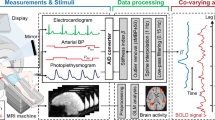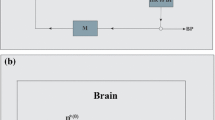Abstract
Activating the arterial baroreceptors in animals has been shown to blunt pain sensation and provide other forms of central nervous system inhibition. This study tested the hypothesis that, among human subjects, a tonic increase in blood pressure (BP) could be a learned response to environmental stressors among subjects in whom the baroreceptor inhibitory mechanism is active. In a sample of 96 healthy, normotensive men and women, amount of pain-reduction produced by baroreceptor stimulation predicted an increase in resting BP 20 months later: the increase was proportional to self-assessed daily life stress. Among the subjects reporting the greatest amount of stress, the pain inhibition effect accounted for more than 80% of the BP variance. These results support the hypothesis that the reduction in perceived stress produced by baroreceptor stimulation may reward learned increases in BP.
Similar content being viewed by others
References
Benson, H., Herd, J. A., Morse, W. H., & Kelleher, R. T. (1969), Behavioral induction of arterial hypertension and its reversal. American Journal of Physiology, 217, 30–34.
Cronbach, L. F., & Furedy, L. (1970), How we should measure “change”—or should we? Psychological Bulletin, 74, 68–80.
Dworkin, B. R. (1988). Hypertension as a learned response: The haroreceptor reinforcement hypothesis. In T. Elbert, W. Langosch, A. Steptoe, & D. Vaitl (Eds.), Behavioral medicine in cardiovascular disorders (pp. 17–47). Chichester: Wiley.
Dworkin, B. R. (1991). The baroreceptor reinforcement instrumental learning (BR-IL) model of essential hypertension: Biological data, quantitative mechanisms, and computer modeling. In A. Shapiro & A. Baum (Eds.), Perspectives in behavioral medicine: Behavioral aspects of cardiovascular disease (pp. 213–245). Hillsdale, NJ: Lawrence Erlbaum Associates, Inc.
Dworkin, B. R. (1993). Learning and physiological regulation, Chicago: University of Chicago Press.
Dworkin, B. R., Elbert, T., Rau, H., Birbaumer. N., Pauli, P., Droste, C., & Brunia, C. H. M. (1994). Central effects of haroreceptor activation in humans: I, Attenuation of skeletal reflexes and pain perception. In Proceedings of the National Academy of Sciences, USA, 91, 6329–6333.
Dworkin, B. R., Filewich, R. J., Miller, N. E., Craigmyle. N., & Pickering, T. G. (1979). Baroreceptor activation reduces reactivity to noxious stimulation: Implications for hypertension. Science, 205. 1299–1301.
Eckberg, D. L., & Sleight, P. (1992). Human buroreflexes in health and disease. Oxford, England: Clarendon.
Graham. D. T., Lundry. R. M., Benjamin, L. S., Kabler, J. D., Lewis. W. C., Kunish, N. O., & Graham. F. K. (1962). Specific attitudes in initial interviews with patients that have different “psychosomatic” diseases. Psychosomatic Medicine, 24, 257–266.
Harris. A. H., Gilliam, W. J., Findley, J. D., & Brady, J. V. (1973). Instrumental conditioning of large-magnitude, daily, 12-hour blood pressure elevations in the baboon. Science, 182. 175–177.
Miller, N. E. (1959). Liberalization of basic S-R concepts: Extensions to conflict behavior, motivation and social learning. In I. S. Koch (Ed.), Psychology: A study of a science (pp. 196–292). New York: McGraw-Hill.
Miller, N. E., Davis, J. D., & Lulenski, G. C. (1968). Comparative studies of barbiturate self-administration. Journal of the Addictions, 3, 207–214.
Miller, N. E., & Dworkin, B. R. (1977). Critical issues in therapeutic applications of biofeedback. In G. E. Schwartz & J. Beatty (Eds.), Biofeedback: Theory and research (pp. 129–161). New York: Academic.
Neter, J., Wasserman, W., & Kutner, M. H. (1985). Applied linear statistical models (2nd ed.). Homewood, IL: Irwin.
Obrist, P. A., Light. K. C., James, S. A., & Strogatz, D. S. (1987). Cardiovascular responses to stress; I, Measures of myocardial response and relationship to high resting systolic pressure and parental hypertension. Psychophysiology, 24, 65–78.
Pickering, T. G. (1991). Ambulatory monitoring and blood pressure variability. London: Science Press.
Pickering, T. G., Brucker, B., Frankel, H. L., Mathias, C, J., Dworkin, B. R., & Miller, N. E. (1977). Mechanisms of learned voluntary control of blood pressure in patients with generalized bodily paralysis. In J. Beatty & H. Legewie (Eds.), Biofeedback and behavior (pp. 225–234). New York: Plenum.
Pickering, T. G., & Gerin, W. (1990), Cardiovascular reactivity in the laboratory and the role of behavioral factors in hypertension: A critical review. Annals of Behavioral Medicine, 12. 3–16.
Plumlee, L. (1969). Operant conditioning of increases in blood pressure. Psychophysialogy, 6, 283–290.
Sutherland, D. H. (1984). Gait disorders in childhood and adolescence. Baltimore: Williams & Wilkins.
Talan, M. I., & Engel, B. T. (1986). Learned control of heart rate during dynamic exercise in non human primates. Journal of Applied Physiology, 61, 545–553.
Turkkan, J. S., & Harris, A. H. (1981). Shaping blood pressure elevations: An examination of acquisition. Behaviour Analysis Letters, 1, 97–106.
Author information
Authors and Affiliations
Additional information
This research was supported by Deutsche Forschungsgemeinshaft Grant EL 101/3 to Thomas Elbert and National Institutes of Health Grant ROl HL40837 to B. R, Dworkin.
We thank Renate Schweizer. Ping Zhuang, and M. Mueller for help in acquiring the data, and Susan Dworkin, Anne Hawkins, Marshall B. Jones, Peter Kaufmann, and Ralph Norgren for advice on the article.
Rights and permissions
About this article
Cite this article
Elbert, T., Dworkin, B.R., Rau, H. et al. Sensory effects of baroreceptor activation and perceived stress together predict long-term blood pressure elevations. Int. J. Behav. Med. 1, 215–228 (1994). https://doi.org/10.1207/s15327558ijbm0103_3
Issue Date:
DOI: https://doi.org/10.1207/s15327558ijbm0103_3




